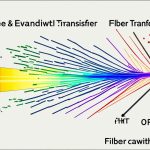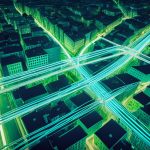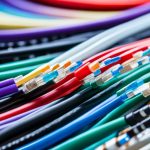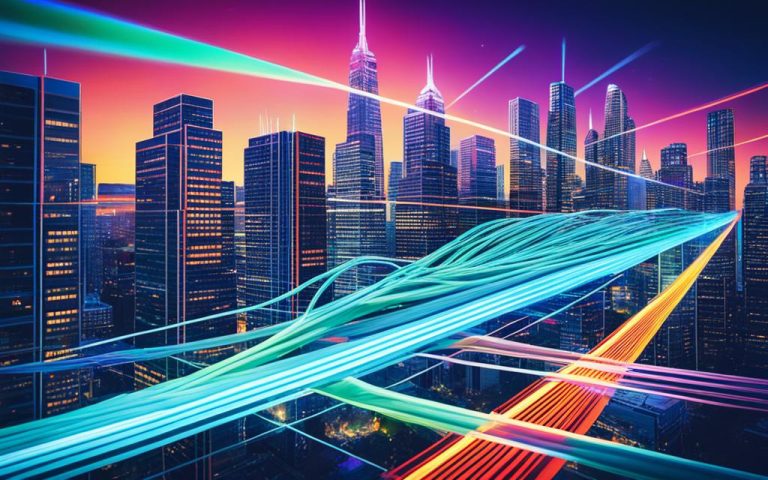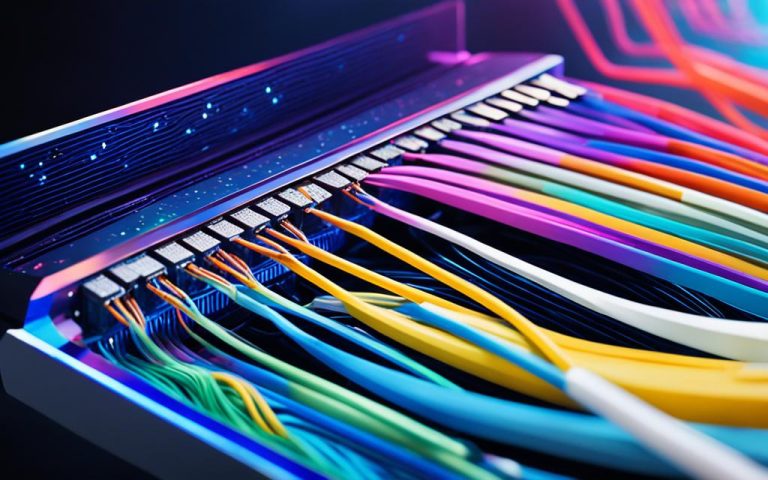In the era of urban living, the development of smart cities has become imperative for sustainable growth and improved connectivity. At the core of this transformation lies the extraordinary potential of fiber optics technology. Optome, a leading company in fiber optic solutions, is playing a pivotal role in realizing the smart city vision.
Why are fiber optics crucial in smart city development? Find out how fiber optics provide unparalleled bandwidth, enabling faster and more reliable communication networks. Unlike traditional copper or coaxial cables, fiber optics are not only energy-efficient but also highly durable. They offer scalability, making them ideal for accommodating the ever-evolving digital landscape of urban environments.
This image demonstrates the transformative power of fiber optics in enabling smart city infrastructure.
Stay tuned as we delve into the importance of fiber optics in smart city development, how it has made smart cities possible, and the integration of fiber optics with LiFi technology. We will also explore essential network considerations that go into smart city plans. Join us on this illuminating journey as we explore the integral role of fiber optics in shaping the urban landscapes of the future.
The Importance of Fiber Optics in Smart City Development
In the rapidly growing landscape of smart cities, fiber optics play a crucial role in enabling sustainable development and driving innovation. As cities strive to enhance urban living and connectivity, fiber optic networks provide the foundation for achieving their smart city goals. With their superior bandwidth, energy efficiency, and scalability, fiber optics pave the way for a smarter and more sustainable future.
Fiber optics enable fast and reliable communication networks, facilitating real-time applications that are essential for smart city development. With fiber optic cables, cities can implement advanced traffic management systems, ensuring efficient mobility and reducing congestion. These cables also support public safety systems, enabling quicker response times and enhancing overall security.
One of the significant advantages of fiber optics in smart city development is its energy efficiency. Compared to traditional copper or coaxial cables, fiber optics consume less energy and contribute to a greener environment. By reducing energy consumption and carbon emissions, fiber optics align with the sustainability goals of smart cities.
Additionally, fiber optics are known for their durability and reliability, making them ideal for urban environments. They are resistant to environmental factors, such as electromagnetic interference and corrosion, and can withstand natural disasters better. This resilience ensures uninterrupted connectivity, regardless of external conditions.
Moreover, fiber optics offer scalability, accommodating the increasing demand for high-bandwidth applications and supporting future technological advancements. Smart city networks are expected to expand and evolve rapidly, and fiber optics provide the necessary flexibility to meet these ever-growing needs.
“Fiber optics are the backbone of smart city development, enabling faster communication, improving energy efficiency, and supporting a range of applications that enhance the quality of urban life.”
The Benefits of Fiber Optics in Smart City Development:
- Fast and reliable communication networks for real-time applications
- Improved traffic management systems and reduced congestion
- Enhanced public safety systems and quicker response times
- Energy efficiency and reduced carbon emissions
- Durable and reliable connectivity, even in challenging conditions
- Scalability to accommodate future growth and technological advancements
Fiber optics are the backbone of smart city development, providing the essential infrastructure that enables sustainable growth and innovation. With their high-speed communication capabilities, energy efficiency, and scalability, fiber optics play a vital role in creating connected and resilient smart cities that enhance the quality of urban life. As cities continue to embrace the benefits of smart technologies, fiber optics will remain a critical component in shaping the cities of the future.
How Fiber Optics Made Smart Cities Possible
Fiber optic technology has revolutionized the development of smart cities, playing a pivotal role in making them a reality. With the advent of fiber optics, cities are now able to establish interconnected technologies that enable seamless communication, data analysis, and information transfer.
One significant area where fiber optics have made a profound impact is in the establishment of surveillance systems, enhancing safety and security within smart cities. The high bandwidth and reliability of fiber optic networks allow for real-time video monitoring and analysis, enabling authorities to effectively manage and mitigate potential threats.
Fiber optics have also played a crucial role in addressing the challenges of traffic congestion and control. By providing faster and more reliable data transmission, fiber optic networks enable smart traffic management systems that can monitor traffic flow, optimize signal timings, and detect and respond to incidents in real-time. This leads to improved traffic control, reduced congestion, and enhanced overall transportation efficiency.
Moreover, fiber optics have paved the way for the development of smart buildings within smart cities. By connecting various building systems, such as lighting, communications, HVAC, and security, fiber optic networks enable centralized control and management, resulting in enhanced energy efficiency, reduced maintenance costs, and improved occupant comfort and safety.
Fiber optics also enhance various city services, including communication networks, lighting systems, transportation infrastructure, and educational institutions. The high bandwidth and reliability of fiber optic networks ensure seamless connectivity and enable the deployment of innovative technologies and applications that enhance the quality of life for residents and businesses.
“Fiber optic technology has been instrumental in transforming smart cities into interconnected, intelligent urban environments. Through its unparalleled communication capabilities, fiber optics have facilitated the development of surveillance systems, improved traffic control, supported the creation of smart buildings, and enhanced various city services.” – Mike Thompson, Director of Infrastructure Development at Optome
As smart cities continue to evolve, the importance of fiber optic technology in supporting infrastructure development, interconnected technologies, surveillance systems, traffic control, and the overall functionality of these cities cannot be overstated.
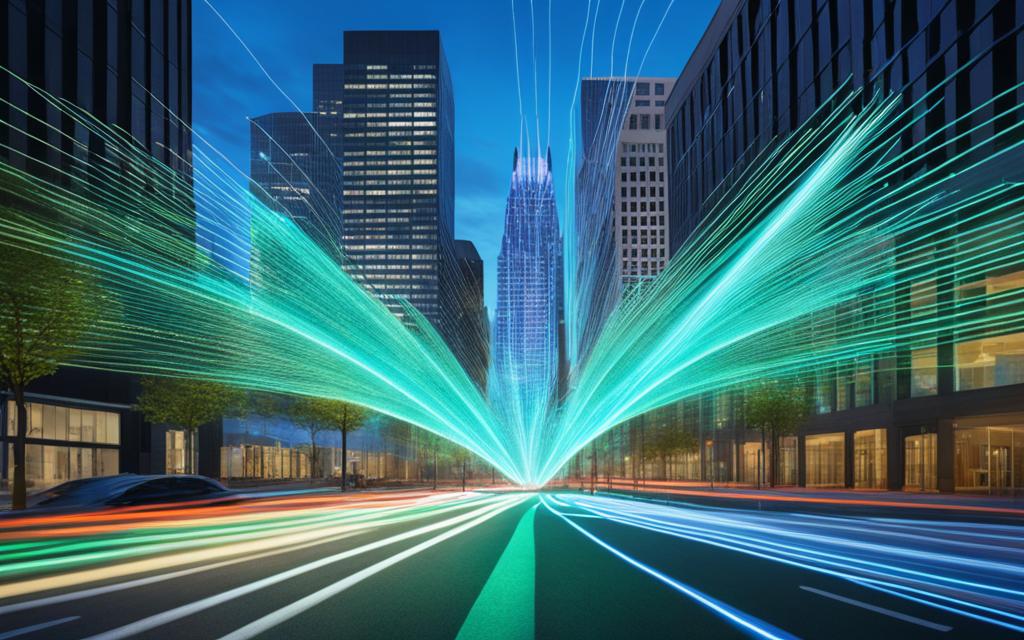
Integrating Fiber Optics and LiFi Technology in Smart Cities
As smart cities continue to evolve, the integration of fiber optics and LiFi technology presents a significant opportunity for advancements in broadband communication. LiFi technology utilizes the power of light waves to transmit data wirelessly at high speeds, revolutionizing connectivity in urban environments.
One of the key components in this integration is LED street lighting, which can serve as access points for LiFi technology. By leveraging existing infrastructure such as streetlights, cities can provide residents and customers with free broadband communication services. This innovative approach not only enhances connectivity but also contributes to the development of sustainable and green smart cities.
The marriage of fiber optics and LiFi technology creates a powerful communications network that extends throughout the city. Fiber optics, known for their exceptional speed and reliability, form the backbone of this network, while LiFi technology utilizes light to provide wireless connectivity to devices. This integration allows for seamless integration of the Internet of Things (IoT) applications, such as smart home automation, intelligent transportation systems, and connected public services.
Integrating fiber optics and LiFi technology not only improves communication capabilities but also enhances customer experiences. With the prevalence of smart devices and IoT applications, seamless connectivity has become a necessity. The combination of fiber optics and LiFi technology ensures fast and reliable connections, enabling users to enjoy uninterrupted access to data and services.
“The integration of fiber optics and LiFi technology unlocks a whole new level of connectivity and possibilities for smart cities. It revolutionizes the way we communicate, interact, and envision urban living.” – [Industry Expert]
Benefits of integrating fiber optics and LiFi technology in smart cities:
- Enhanced broadband communications
- Improved IoT applications and connectivity
- Cost-effective utilization of existing infrastructure
- Reduced carbon footprint through energy-efficient technologies
- Enhanced customer experiences and satisfaction
By prioritizing the integration of fiber optics and LiFi technology, smart cities can create a connected ecosystem that fosters innovation, improves quality of life, and promotes sustainable growth.
Network Considerations for Smart City Plans
When developing smart city plans, careful consideration must be given to the network infrastructure that will support the city’s digital transformation. A robust and efficient network is crucial for enabling smart city applications and services to function seamlessly. In this section, we will explore the key network considerations for smart city plans, including the use of fiber optic and LiFi networks, network resilience, and the importance of backhaul networks.
The Role of Fiber Optic Networks
Fiber optic networks play a vital role in smart city plans by providing high-speed and reliable communication capabilities. With their unparalleled bandwidth, fiber optic cables enable faster data transmission, supporting real-time applications and services. These networks also have enhanced security features, making them more resilient against cyber threats. By implementing a fiber optic network infrastructure, smart cities can ensure seamless connectivity and support future growth.
Complementing Fiber Optics with LiFi Networks
In addition to fiber optics, smart city plans can benefit from the integration of LiFi networks. LiFi technology utilizes LED lights to transmit data wirelessly, offering high-speed, secure, and energy-efficient communication. By leveraging existing LED street lighting infrastructure, LiFi networks can provide broadband connectivity, contributing to widespread internet access across the city. The combination of fiber optics and LiFi networks creates a comprehensive and versatile network infrastructure for smart cities.
Ensuring Network Resilience
Network resilience is a critical consideration for smart city plans. To maximize uptime and ensure uninterrupted connectivity, smart city networks should be designed with robust network resilience measures. This involves implementing redundant network architecture, backup power systems, and proactive network monitoring and maintenance practices. By prioritizing network resilience, smart cities can minimize downtime, enhance service reliability, and optimize resource utilization.
The Significance of Backhaul Networks
Backhaul networks are essential for wireless networking in smart cities. These networks serve as the backbone for transporting data between the end-user devices and the central network infrastructure. Fiber optic networks play a crucial role in supporting efficient and reliable backhaul connections, enabling seamless communication between the various components of the smart city ecosystem. Strong backhaul networks are vital for meeting the increasing demand for high-bandwidth applications and services in smart cities.
In summary, smart city plans must prioritize network considerations to ensure the successful implementation and operation of various applications and services. This includes leveraging the capabilities of fiber optic and LiFi networks, ensuring network resilience, and establishing robust backhaul networks. By building a strong and scalable network infrastructure, smart cities can create a foundation for sustainable growth, innovation, and improved quality of life for their residents.
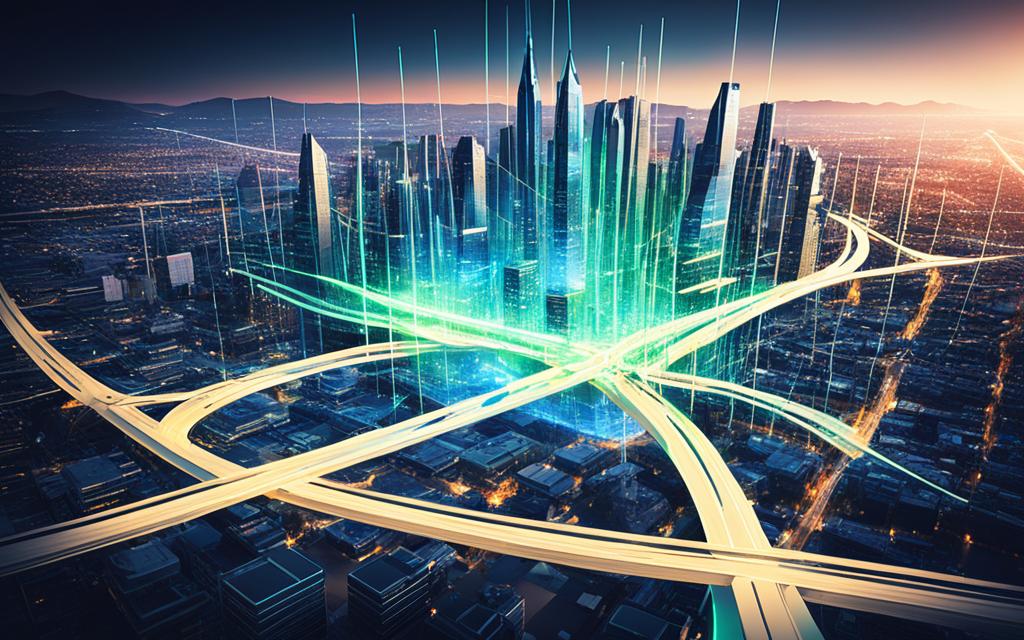
Conclusion
Fiber optics and LiFi technology are critical components in the development of smart cities, offering numerous benefits for urban environments. By incorporating fiber optics, cities can achieve faster and more reliable communication, enabling real-time applications for traffic management and public safety systems. The use of fiber optic cables also promotes sustainability, with their energy efficiency and durability contributing to a more sustainable infrastructure.
In addition to fiber optics, the integration of LiFi technology opens up new possibilities for smart city applications. LiFi utilizes visible light to provide wireless connectivity and high-speed data transmission, offering an alternative to traditional broadband communication. This integration can greatly enhance customer satisfaction, as LED street lighting can also serve as access points for free broadband services.
By leveraging the power of fiber optics and LiFi technology, smart cities can create efficient and interconnected urban environments. These technologies provide the necessary bandwidth, scalability, and reliability for smart city networks, supporting various services and improving infrastructure sustainability. In conclusion, the combination of fiber optics and LiFi technology paves the way for more sustainable, connected, and customer-centric smart cities.
FAQ
What is the role of fiber optics in smart city development?
Fiber optics play a key role in smart city development by providing unparalleled bandwidth for faster and more reliable communication networks. They also offer energy efficiency, durability, and scalability compared to traditional copper or coaxial cables.
How do fiber optics contribute to the sustainability of smart cities?
Fiber optics contribute to the sustainability of smart cities by being more energy-efficient, reducing energy consumption and carbon emissions. They are also durable and reliable, with better resistance to environmental factors and natural disasters. Additionally, fiber optics accommodate future growth and technological advancements.
How did fiber optics make smart cities possible?
Fiber optics revolutionized the infrastructure development of smart cities by enabling interconnected technologies for communication, analysis, and information transfer. They support surveillance systems, traffic control and monitoring, and the development of smart buildings. Fiber optics also enhance various city services such as communications, lighting, transportation, and education.
What are the possibilities of integrating fiber optics and LiFi technology in smart cities?
The integration of fiber optics and LiFi technology offers exciting possibilities for smart cities. LiFi technology utilizes visible light, ultraviolet, and infrared spectra for high-speed wireless data communications. LED street lighting can serve as LiFi access points, providing free broadband communications services to customers and residents. This integration can support IoT applications, improve customer experiences, and contribute to sustainable and green infrastructure.
What should be considered in the network infrastructure planning for smart cities?
Smart city plans require careful consideration of network infrastructure. Fiber optic networks provide high-speed communication capabilities, and wireless technologies like LiFi can complement them. Backhaul networks are necessary for wireless networking, and fiber optics can support efficient and reliable backhaul connections. Network resilience measures, such as enclosed environments for network devices, can enhance the longevity and effectiveness of smart city networks.
What are the benefits of fiber optics and LiFi technology in smart cities?
Fiber optics and LiFi technology play integral roles in the development of smart cities. They enable faster communication, improve infrastructure sustainability, enhance customer experiences, and support various city services. Fiber optics provide the necessary bandwidth, energy efficiency, durability, reliability, and scalability for smart city networks. LiFi technology offers wireless connectivity and data transmission through visible light, expanding the possibilities for smart city applications. By leveraging fiber optics and LiFi technology, cities can create more sustainable, connected, and efficient urban environments.




